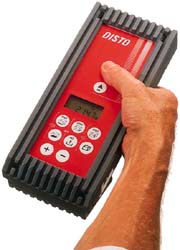|
              
THE TECHNICAL PAGES
The DISTO Laser distance meter (by Guy Van Rentergem)
When I saw at a trade-show a leaflet of the world's first "handheld laser
distance meter", I immediately thought of the possible use of this instrument
for cave surveying purposes. Measuring distances, up to 100 m, with an amazing
0.3 cm precision. It seemed more like science-fiction to me!
So, put you old measuring-tapes away, here comes the Disto. As you can
read in another article, the good old Suunto clinometer has also become
redundant....
Working with the Disto is child's play. Press the button once and the
laser is activated. Aim the laser beam (the red spot is very visible) and
press the button a second time. After a few seconds, the distance is shown
on the LCD-display. Could it be any easier?
The advantages of this device are numerous. Here are some examples, just
use your imagination and you'll find a dozen more:
- In muddy conditions, you don't have to worry anymore about muddy measuring
tapes.
- Tapes wear quickly: the digits fade away and in the cave, you'll risk
mis-interpretation of the distances. With the Disto, this belongs to the
past.
- Long distances are as precise as short ones. When using a tape, long distances
will be over-estimated since the tape bends through.
- How high is this room, or aven? No problem. You know it within seconds.
- How deep is this pitch? No need to use two or more measuring tapes that
are tied together, or Topofils that break while abseiling.
- Splendid white formations where you must try to pull your muddy tape in
between without muddying them? From now on, just aim your Disto!
- How long is this lake? You'll know it without having to swim to the other
side.
- My survey partner didn't show up... I'm alone. Thanks to the Disto, solo-surveying
has become a lot easier.
BUT, there is one disadvantage too... the PRICE. This little beauty costed
in 1996 some 45000 BEF (= 1200 USD) V.A.T. not included. Actually (1998),
prices have dropped at least 20 % and let's hope that this trend continues. !
!
The next step in surveying caves electronically, is combining the DISTO
with the BOSCH electronic level. And then, why not, an electronic compass
(and a computer perhaps?).
USING THE DISTO IN THE FIELD (Paul De Bie)
I had the pleasure to use the DISTO during several 6-hour survey sessions.
The conditions were extremely muddy and using a normal tape, we surely would
have been obliged to end the surveying after a couple of hours, because
of a mud-covered tape. All advantages that Guy sums up in his article are
true!
The DISTO allowed every time again a good and precise reading, even when
aimed at muddy surfaces, cave walls or rocks. But we preferred to aim it
at the back of my survey notebook. The DISTO will give you an immediate
reply when aimed at a smooth surface. If you point it at a rough surface
(rocks for instance), it will try to make an average by repeating the measurements
during a few seconds.
Guy mentioned as the only disadvantage the high price of this thing.
There are some other minor disadvantages.
- It is relatively big and heavy.
- It is robust and waterproof, but since it contains hi-tech electronics,
you should be careful with it.
- The front lens has a special coating that can be easily scratched. I don't
think you can cover it with a piece of plexi, since this would disturb the
laser beam.
But, as a whole, this is good stuff and the future of it looks very promising
indeed!
SOME TECHNICAL SPECIFICATIONS
This device uses an "amplitude modulated laser beam". The reflected laserlight
that returns from the object that you are measuring to, is compared with
a reference laser beam. The phase-shift is calculated and is directly proportional
to the distance that was measured (thus permitting to calculate the distance).
It is powered by a build-in rechargeable battery.
History:
The first laser distance meter was already constructed in 1948 by a Swedish
guy called Bergstrand. It could measure distance up to 40 kilometres. It
took another 50 years before micro-electronics and small laserdiodes permitted
to build small and handheld versions of this device.
Technical specifications:
Precision ? 3 millimetres
Maximal error ? 5 millimetres
Maximal reach: 100 metres
Dimensions (millimetres): 235 x 104 x 59 mm
Weight: 780 g
Number of measurements per battery charge: 400
Time to charge the battery: 1 hour (can be done though the cigarette-lighter
of a car)
Working temperature range -10 C to + 50 C
Laser: 670 nanometre, 2 mW, laserclass 2 (IEC 825)
If you want to know more about the Disto lasermeters, then consult
the site of Leica:
http://www.leica.com/surveying/product/disto.htm
The Disto exists in many models, even one that stores all readings and
can be linked to a P.C. afterwards.
Meanwhile (april 1998) has BOSCH also a similar device, the DLE 30. It will
probably be cheaper than the Leica.
|
